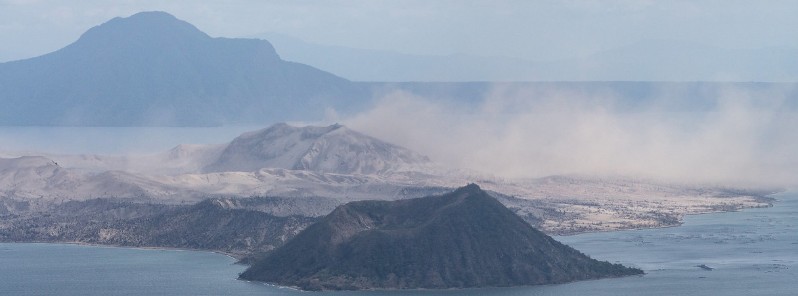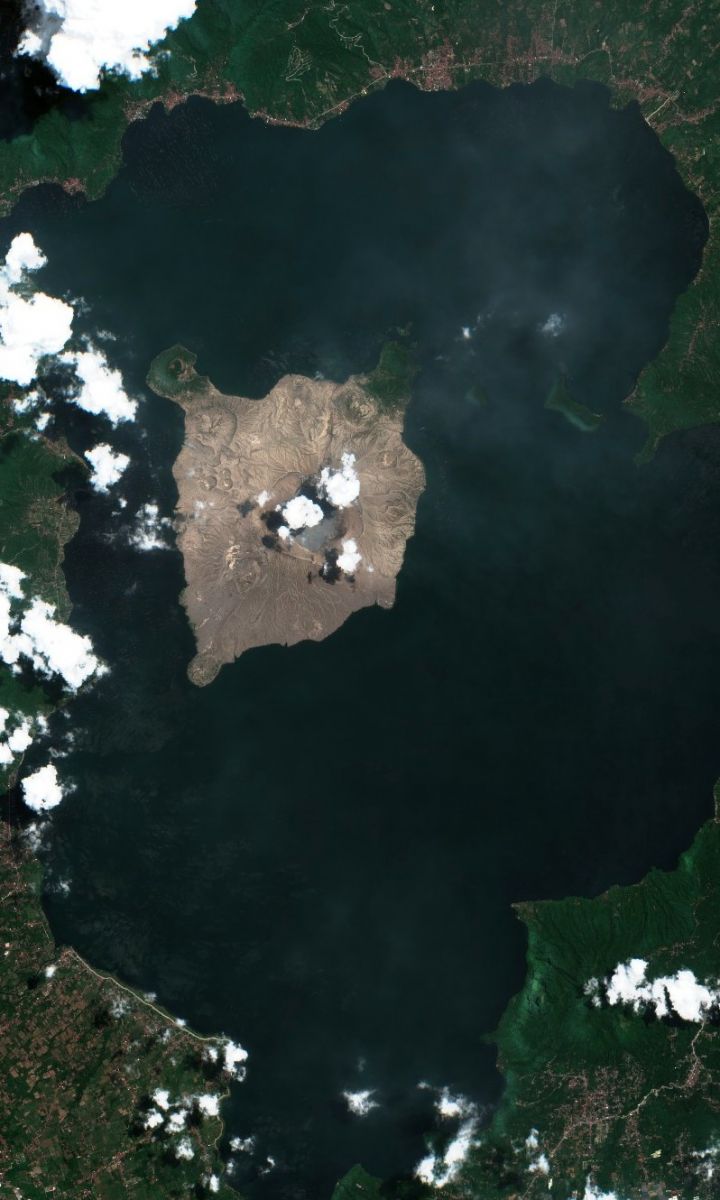Highest ever recorded SO2 emission over Taal, adverse effects reported, Philippines

High levels of volcanic sulfur dioxide or SO2 gas emissions and tall, steam-rich plumes have continued to be produced from the Taal Main Crater since this past weekend, PHIVOLCS reported on Tuesday, June 29, 2021. Unprecedented SO2 emissions were recorded on June 28, causing adverse effects on some residents living near the volcano.
SO2 emission on June 28, 2021, averaged 14 326 tonnes/day — the highest ever recorded in Taal — while atmospheric temperatures of 34 °C (93.2 °F), relative humidity of 53%, and wind velocities of 1 to 4 meters/second within 3 km (1.8 miles) of the atmosphere prevail over Taal Volcano today, June 29.
The high SO2 flux, water vapor emitted in plumes, weak air movement, and solar radiation will continue to produce volcanic smog or vog over the Taal Caldera region, particularly towards the northeast and eastern lakeshore communities along the current wind direction.
PHIVOLCS has received reports of adverse effects on some residents of lakeshore Tanauan City and Talisay Municipality facing Taal Volcano Island, and on some workers of aquaculture in Taal Lake, have been received by DOST-PHIVOLCS.
#TaalVolcano in action!
Two #Copernicus images: #Sentinel2 on Jun 26 shows the area of the #Taal #volcano, while the #Sentinel5p on Jun 28 detected the SO2 emissions, the highest ever recorded as reported by @phivolcs_dost. #volcano #Philippines #Airquality @CultureVolcan pic.twitter.com/OmCbEXYPO8— ADAM Platform (@PlatformAdam) June 29, 2021
"In view of continuous and unprecedented high SO2 degassing from Taal Main Crater, we recommend that health checks be conducted by local government officials on communities affected by vog to assess the severity of SO2 impacts on their constituents and to consider temporary evacuation of severely exposed residents to safer areas," PHIVOLCS said.
Local government units (LGU) were advised to regularly check the weather and wind forecasts of PAGASA in order to assess the potential exposure of their constituents so long as SO2 emission remains elevated.
Lastly, LGUs were advised to monitor activities of aquaculture workers to ensure that no one ventures too closely to Taal Volcano Island and gets exposed to lethal concentrations of volcanic SO2.
Vog consists of fine droplets containing volcanic gas such as SO2 which is acidic and can cause irritation of the eyes, throat and respiratory tract in severities depending on the gas concentrations and durations of exposure. People who may be particularly sensitive to vog are those with health conditions such as asthma, lung disease and heart disease, the elderly, pregnant women and children.
For communities that can be affected by vog, please be mindful of the following:
- Limit your exposure. Avoid outdoor activities, stay indoors and shut doors and windows to block out vog.
- Protect yourself. Cover your nose, ideally with an N95 facemask. Drink plenty of water to reduce any throat irritation or constriction. If belonging to the particularly sensitive group of people above, watch over yourself and seek help from a doctor or the barangay health unit if needed, especially if serious effects are experienced.
Alert Level 2 (Increased Unrest) remains in effect over Taal Volcano. Sudden steam- or gas-driven explosions and lethal accumulations or expulsions of volcanic gas can occur and threaten areas within and around Taal Volcano Island (TVI).
Venturing into TVI is strictly prohibited.
Additionally, many people fear the haze which is being experienced by some residents of Metro Manila is vog. However, this is smog caused by pollution and human activity, PHIVOLCS said.

Taal volcano on June 26, 2021. Credit: Copernicus EU/Sentinel-2, TW
Geological summary
Taal is one of the most active volcanoes in the Philippines and has produced some of its most powerful historical eruptions. Though not topographically prominent, its prehistorical eruptions have greatly changed the topography of SW Luzon.
The 15 x 20 km (9 x 12 feet) Talisay (Taal) caldera is largely filled by Lake Taal, whose 267 km2 (103 mi2) surface lies only 3 m (9.8 feet) above sea level.
The maximum depth of the lake is 160 m (525 feet), and several eruptive centers lie submerged beneath the lake. The 5 km (3.1 miles) wide Volcano Island in north-central Lake Taal is the location of all historical eruptions.
The island is composed of coalescing small stratovolcanoes, tuff rings, and scoria cones that have grown about 25% in the area during historical time. Powerful pyroclastic flows and surges from historical eruptions have caused many fatalities. (GVP)
Featured image: Photo taken from Tagaytay Ridge on February 28, 2020. Credit: Ray in Manila

I, AND MANY OTHERS WOULD COMPLETELY AGREE. BULLS**IT IS THE COMMON LANGUAGE USED IN AMERICA AMPLIFIED BY SENSATIONALISM WITH MORE THAN A TOUCH OF OUT AND OUT LIES. NOW THE QUESTION BY PEOPLE WHO MAKE UP THIS NONSENSE POSED IS “CAN WE MAKE A BUCK ON IT”.
Some of your writers like Sensationalism….misleading with titles. Such as this: “Highest ever recorded SO2 emission over Taal”, which suggests World’s highest ever, rather than being worded “Highest S02 emission over Taal ever recorded”. Simple change, but it makes you seem like a quack organization when you are stretching for hits like this! This should be below you!